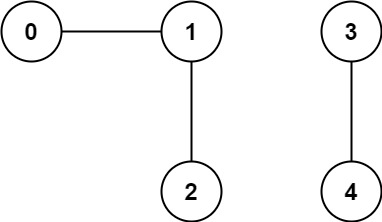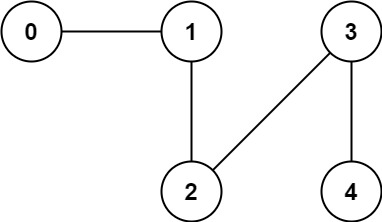题目(LeetCode #323)
你有一个包含 n 个节点的图。给定一个整数 n 和一个数组 edges ,其中 edges[i] = [ai, bi] 表示图中 ai 和 bi 之间有一条边。
返回 图中已连接分量的数目 。
示例1:

输入: n = 5, edges = [[0, 1], [1, 2], [3, 4]]
输出: 2
示例2:

输入: n = 5, edges = [[0,1], [1,2], [2,3], [3,4]]
输出: 1
提示:
1 <= n <= 20001 <= edges.length <= 5000edges[i].length == 2- 0 <= ai <= bi < n
- ai != bi
edges 中不会出现重复的边
题解
BFS
1
2
3
4
5
6
7
8
9
10
11
12
13
14
15
16
17
18
19
20
21
22
23
24
25
26
27
28
29
30
31
32
| class Solution {
public int countComponents(int n, int[][] edges) {
if (n == 0 || edges == null) return 0;
List<List<Integer>> adjList = new ArrayList<>();
for (int i = 0; i < n; i++) adjList.add(new ArrayList<>());
for (int[] edge : edges) {
adjList.get(edge[0]).add(edge[1]);
adjList.get(edge[1]).add(edge[0]);
}
int count = 0;
boolean[] visited = new boolean[n];
for (int i = 0; i < n; i++) {
if (visited[i]) continue;
count++;
Deque<Integer> queue = new ArrayDeque<>();
queue.add(i);
while (!queue.isEmpty()) {
int cur = queue.poll();
visited[cur] = true;
for (int next : adjList.get(cur)) {
if (!visited[next]) queue.add(next);
}
}
}
return count;
}
}
|
DFS
1
2
3
4
5
6
7
8
9
10
11
12
13
14
15
16
17
18
19
20
21
22
23
24
25
26
27
28
29
30
31
32
33
34
35
| class Solution {
private int n;
private boolean[] visited;
List<List<Integer>> adjList;
public int countComponents(int n, int[][] edges) {
if (n == 0 || edges == null) return 0;
this.n = n;
adjList = new ArrayList<>();
visited = new boolean[n];
for (int i = 0; i < n; i++) adjList.add(new ArrayList<>());
for (int[] edge : edges) {
adjList.get(edge[0]).add(edge[1]);
adjList.get(edge[1]).add(edge[0]);
}
int count = 0;
for (int i = 0; i < n; i++) {
if (!visited[i]) {
dfs(i);
count++;
}
}
return count;
}
public void dfs(int i) {
if (visited[i]) return;
visited[i] = true;
for (int next : adjList.get(i)) dfs(next);
}
}
|
并查集
1
2
3
4
5
6
7
8
9
10
11
12
13
14
15
16
17
18
19
20
21
22
23
24
25
26
27
28
29
30
31
32
33
34
35
36
37
38
39
40
| class UnionFind {
private int[] parents, rank;
int unionCnt = 0;
public UnionFind(int[] parents) {
this.parents = parents;
this.rank = new int[parents.length];
Arrays.fill(this.rank, 1);
}
public int find(int x) {
if (parents[x] == x) return x;
return parents[x] = find(parents[x]);
}
public void union(int x, int y) {
int xRoot = find(x), yRoot = find(y);
if (xRoot == yRoot) return;
unionCnt++;
if (rank[yRoot] <= rank[xRoot]) parents[yRoot] = xRoot;
else parents[xRoot] = yRoot;
if (rank[xRoot] == rank[yRoot]) rank[xRoot]++;
}
}
class Solution {
public int countComponents(int n, int[][] edges) {
if (n == 0 || edges == null) return 0;
int[] parents = new int[n];
for (int i = 0; i < n; i++) parents[i] = i;
UnionFind uf = new UnionFind(parents);
for (int[] edge : edges) uf.union(edge[0], edge[1]);
return n - uf.unionCnt;
}
}
|

